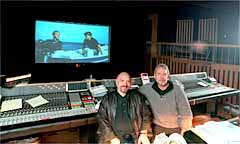Sedona Filmmaking Workshop |
Sedona Filmmaking Workshop |
"In Murch's most recent project, he indirectly worked with one of the great mavericks of modern cinema, Orson Welles. In restoring Touch of Evil (1958), one of the greatest film noir thrillers and yet another Welles film that suffered from studio interference (to the point where Welles was barred from the lot and the movie was finished by another hand) . . . Touch of Evil was loaded reel by reel into an Avid nonlinear editing workstation, where Murch cleaned up the pictures and remixed the audio as an 8-track digital soundtrack. It is generally held that film making has moved away from the old mag recorder methods but Murch says that it is still relatively new for him. 'Last year I remastered the soundtracks of The Godfather trilogy using it and I've made a few music videos that way but the first film I worked on using it from start to finish was The English Patient. Surprisingly it is also the first film to have been edited electronically and win an Oscar. I would have assumed that this barrier would have been passed before that but it's not the case.' . . . In terms of the differences between the old and new technologies, Murch says that the primary one is flexibility, with computers bringing more functionality. 'For the sound on The English Patient we used the Sonic Solutions system. . . . " (quote by Kevin Hilton, "Walter Murch: The Sound Film Man," Sound Studio, May 1, 1998)
"I think you could make an argument that the biggest change probably anywhere in the film industry, technologically speaking, is in sound over the last 30 years, which is when I started out. I mean in the late '60s we were using a technology that aside from recording onto magnetic film, was really exactly the same as it had been in the late 1930s. So for the 30 years previous there really had been very little change, certainly compared to the change that's happened since the late '60s up to today. But currently I'm editing on an Avid and we're projecting the dailies using ProTools. We're entirely Mac-based. There are probably seven or eight Macintoshes within striking distance and for the most part G3s. I think we have Avid running off of a 9600. But I've been using Macs since the mid-80s. It's the world that I've lived in and continue to live in. . . . The projection of the film itself‹the 35mm film‹has traditionally required 35mm magnetic film to run in sync with it when you project dailies. When you're editing on Avid however, the magnetic film, typically 300,000 feet of material, is used once for the screening and thrown into the garbage. This so bothered me on the last film I worked on, The English Patient, that I invented a system by which we can sync the sound in the AVID and export it on a Jaz disk and open it up in ProTools as a ProTools sound file and then via some DigiDesign interface unit we can run the sound off the Jaz drive while projecting the 35mm film. And I've put together a portable unit with a portable projector wherever we were on location. Instead of 300,000 feet of tape we have seven Jaz drives that contain all the sound for the entire film." (quote from King Murch by Apple Design & Publishing)
 |